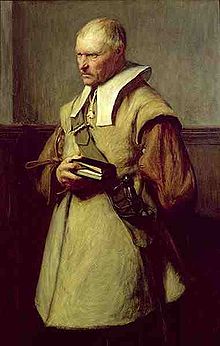Roundhead

As Roundheads ( English for Roundheads ) were during the English Civil War, the followers of Parliament designated 1642 to 1649. Their enemies, the royalists under King Charles I , one the other hand, called Cavaliers (English: Cavaliers ).
Origin and meaning
Some Puritans , who formed the core of the anti-royalist and anti- high church forces, wore short hairstyles that were close to the head. This happened in demonstrative contrast to the nobles, who wore shoulder-length locks, following the courtly fashion of the time. The hairstyle was a deliberate departure from the alleged effeminacy and decadence at the court of Charles I.
The name round heads was used by their opponents in the run-up to the civil war and was intended as a mockery. In the parliamentary army , the New Model Army , it was therefore a punishable offense to call a soldier who was fighting a round head. As a party name, Rundkopf remained in use until after the Glorious Revolution of 1688 in order to identify all people with a republican sentiment.
The term first appeared at the end of 1641 when the parliamentary debate about the Bishop's Exclusion Bill , with which the majority Puritan House of Commons wanted to exclude the Anglican bishops from the House of Lords , caused tumult in Westminster . One official spoke of the crowd that gathered there:
"They wear their hair just a little longer over their ears, which is why all those who used to go screaming to Westminster came up with the nickname Round Head."
John Rushworth is more specific in his ( Historical Collections ). After him, the word was first used on December 27, 1641 by a dismissed royalist officer named David Hide . He is said to have drawn his sword during a tumult and said that he would "cut the throats of all round-headed dogs that bawl at the bishops".
Charles II's chief adviser , the historian Edward Hyde, 1st Earl of Clarendon , noted in his History of the Rebellion (Volume IV, p. 121):
“[...] and from these protests on, the two terms Roundhead and Cavalier increasingly appeared in speeches [...] they who were viewed as servants of the king were called Cavaliers , and the other rabble was despised and insulted as Roundheads . "
Richard Baxter suspects the origin of the term in a remark made by Charles I's wife, Queen Henrietta Maria , during the trial against the Earl of Strafford . In relation to his opponent John Pym, she is said to have asked who this round-headed man was.
During the civil war, the round heads could be recognized by their orange sashes and the cavaliers by their red sashes.
source
- Encyclopaedia Britannica from 1911